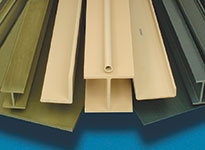How Do Fiberglass Structural Shapes Withstand Uniform Loads?
What is a Uniform Load?
Load is defined as the outside effort acting on a structure. The load usually alters the structure’s shape, which can cause plastic deformation. When this loading force is distributed across an entire region of an element – such as a slab or beam – it is described as a uniform load. The weight of this load typically stays constant throughout the entire element. How a given structural element responds to uniformly distributed loads depends on the force, as well as the length and strength of the element.

What are Fiberglass Structural Shapes?
Fiberglass structural shapes are a composite consisting of a polymer resin matrix reinforced by embedded glass fibers. The strength of a fiberglass structural shape is determined primarily by the type, orientation, quantity, and location of the glass fibers within the composite.
Benefits of Fiberglass Structural Shapes
In recent times, fiberglass structural shapes and parts have been increasingly used instead of traditional steel systems which embody the archetypical construction material worldwide.
Fiberglass structural shapes are manufactured by reinforcing a functional liquid resin matrix with an inorganic textile followed by profiling and curing of the near-net-shape. The end-product’s properties depend on these constituent parts, however fiberglass structural shapes have a reputation for excellent strength-to-weight performance ratios.
Fiberglass structural shapes are generally 75% lighter than steel and 30% lighter than aluminum. They can also be easily modified using standard carpentry tools and can be lifted in to place easily during installation with less specialized equipment or labor when compared to steel. This simple installation means that fiberglass structural shapes are less costly to install - as much as 15% less than carbon steel, 30% less than galvanized steel, and as much as 50% less than stainless steel.
Additionally, fiberglass structural shapes have extremely low electrical and thermal conductivity properties and are less of a potential shock hazard when compared with steel and aluminum.
The Impact of Uniform Loads of Fiberglass Structural Shapes
Fiberglass structural shapes are strong despite being lightweight. They have higher flexibility, meaning that they are not brittle and will not buckle under weight. This makes them ideal for taking the weight of a uniform load which often can cause irreparable damage to structural steel.
Fiberglass Structures from Strongwell
Strongwell’s shatterproof fiberglass structural shapes are flexible, strong, and solid. Compared to structural timber, EXTREN® structural shapes from Strongwell have a higher flexural strength with excellent resistance to extreme bending. EXTREN® exhibits a tensile strength of up to 30,000 psi and a flexural modulus of 10,000 psi.
For more information, contact us today.